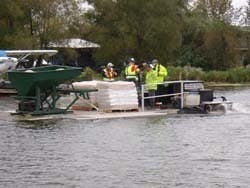About the author: Gerold Morrison, Ph.D., is senior water resources scientist for AMEC Environment & Infrastructure Inc. Morrison can be reached at [email protected] or 863.640.2385.
In coming years, it appears likely that most water quality managers in the U.S. will spend at least a portion of their time working on nutrient management issues. In 2009, the U.S. Environmental Protection Agency (EPA) estimated that water quality conditions in more than 1.9 million acres of U.S. lakes, more than 38,000 miles of rivers and streams, and more than 1,000 sq miles of estuarine waters are impaired as the direct result of elevated nutrient inputs.
When indirect impacts of nutrient pollution—such as organic enrichment and dissolved oxygen depletion—are included in the national assessment, the areas affected roughly double. Phosphorus and nitrogen are the nutrients causing most of these impairments, with phosphorus being a primary cause in freshwater systems and nitrogen (or a combination of phosphorus and nitrogen) playing a major role in estuarine and coastal waters.
In response to this issue, several federal regulatory initiatives—such as the total maximum daily load, National Pollution Discharge Elimination System and municipal separate storm sewer system programs—have focused additional attention on nutrient-related impairments. Numeric nutrient criteria for phosphorus and nitrogen recently have been promulgated for Florida waters, and are anticipated for other states in the future. As cost-effective new tools are developed to address nutrient impairments, managers will have strong incentives to become familiar with them, incorporating them into their water quality restoration and protection projects.
Like the U.S., Australia contains a large number of nutrient-impaired freshwater bodies with impairments caused primarily by elevated levels of biologically available phosphorus (BAP). To help manage these impairments, researchers at two Australian agencies—the Commonwealth Scientific and Industrial Research Organization and the Western Australia Water and Rivers Commission—have investigated the use of lanthanum-modified bentonite clay to bind BAP under a range of environmental conditions.
Rare Earth Element
Lanthanum, which is classified as a “rare earth element,” appears particularly well-suited for use as a phosphorus management tool. It preferentially binds with phosphate (PO43-) ions, forming a naturally occurring mineral (rhapdophane) that is essentially insoluble in water (Ksp < 10-25). This characteristic has led lanthanum to be used as a human medication in the drug Fosrenol, which is prescribed to manage serum phosphorus levels in patients suffering from advanced kidney disease.
The ability to bind phosphate ions also lends itself to water quality management applications. Modified clay minerals based on lanthanum are “especially effective, removing phosphorus from solution and firmly immobilizing it in the particulate sedimentary fraction,” while providing “the phosphorus-binding properties of metal oxides and hydroxides, but without causing the toxicity problems that direct dosing of (say) iron or aluminum salts might cause to water bodies.”
Toxicity Considerations
At high concentrations, lanthanum ions can pose toxicity risks for sensitive aquatic organisms, including some zooplankton and fish species. A key element of the Australian research effort was the development of a clay-based material in which lanthanum is embedded within a bentonite matrix this is done using an ion-exchange process in which lanthanum takes the place of some of the sodium ions within the matrix.
Although toxicity issues still can be encountered when using these modified clay materials, they appear limited to special situations (e.g., receiving waters containing very low concentrations of oxy-anions such as PO43- or CO32-) that would allow high concentrations of free lanthanum ions to remain in the water column following an application. Such situations can be avoided by careful pre-application monitoring and the use of appropriate dosing rates, and ecotoxicity does not appear to be a significant risk when the materials are applied to eutrophic, phosphorus-enriched water bodies that offer abundant binding opportunities for lanthanum ions.
Production & Application
Following successful field trials in Australia, a specific formulation of lanthanum-modified bentonite clay has been licensed for commercial production and currently is being used to address phosphorus-related eutrophication issues on a worldwide basis. Data collected during the initial research studies and subsequent field trials indicate that the material is highly efficient in stripping BAP from the water column and intercepting internally recycled BAP as it is released from aquatic sediments.
Bioassay studies indicate that the product does not pose a toxicity threat to humans or aquatic organisms when used as directed for eutrophication control purposes. The material is simple to apply in either a granular or slurr3y form, appears to be cost-effective relative to other commercially available phosphorus binding materials, and recently has been approved under NSF/ANSI Standard 60 for use in potable water treatment.
Utilization of the lanthanum-modified bentonite clay may offer a significant solution for water management professionals across the U.S., and further study of the application should be considered in various climates and open-water systems.


